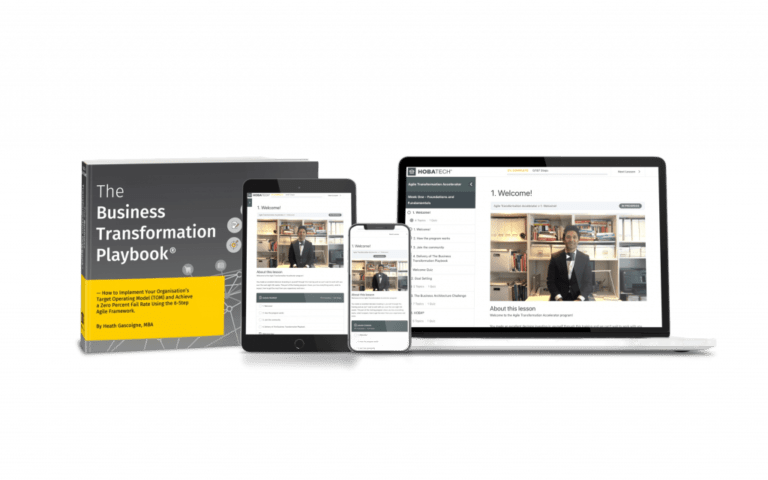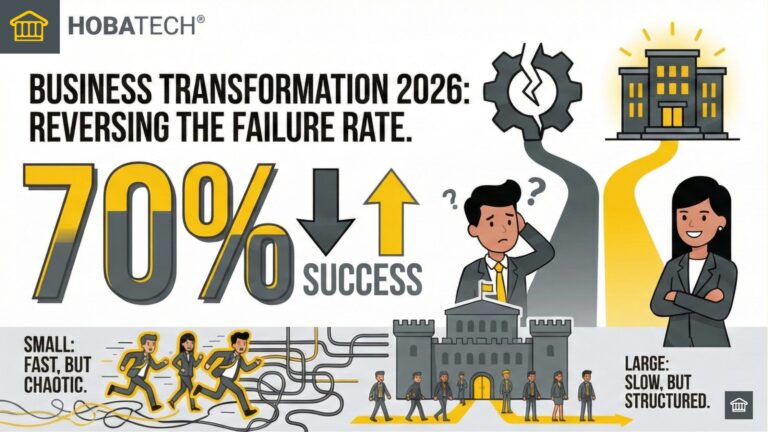Organizational transformation can be daunting, but knowing the dos and don’ts can make a significant difference.
This blog post outlines five critical dos and don’ts to help guide your transformation journey.
From avoiding excessive planning to ensuring executive accountability, these insights will prepare your organization for successful change.
Did you know that a whopping 70% of businesses fail to achieve a successful digital transformation?
Although most companies know how crucial technology is to their business and evolving with the changing times will eventually dictate their success – but effectively implementing the change is an entirely different story altogether.
Many businesses with big plans have attempted to digitalize their operations – only to hit a dead end.
Understanding what goes wrong backstage is crucial, so we have compiled a brief guide on what to do and what not to do when trying to go digital.
Heres what we’ll cover (click the links to skip to the section below):
NB – Click to expand images 📸
Table of Contents
- Don’ts:
- 1. Going Overboard in Planning Your Work Objectives
- 2. Creating a Structure Where Decision Makers Have No Accountability
- 3. Getting Any One Other the Senior Leaders to the Business Strategy
- 4. Limiting the Creation and Implementation of the and Business to One Department or Subdivision
- 5. Guerrilla Warfare - Getting the Change Driven by Directors
- Do's
- 1. Apply Program and Project Discipline
- 2. Get Your Executive Board to Own and Develop the Business Strategy
- 3. Have the Senior Leadership Team Take Accountability for the Success of the Project and Realised Benefits
- 4. Stay on Track (Avoid Getting Side Tracked)
- 5. Focus-on-a-Small-Number-of-Key-Pillars
- Conclusion
Don’ts:
1. Going Overboard in Planning Your Work Objectives
No, this shouldn’t stop you from being ambitious or thinking about going digital – but going overboard with your plans or engaging in haphazard planning could seriously harm your business.
This puts all the efforts, resources, and time invested into the transformation at stake. But what takes the biggest hit is your reputation as a brand when you fail to deliver. And nothing can be worse for a business than to fail at delivering. One such example is of Proctor and Gamble.
In 2012, the company decided to go all out on their digital transformation – keep in mind the company was already leading the industry. This ambitious goal lead to ambitious initiatives that lacked one MAJOR thing – a definite purpose. This lack of purpose lead to the CEO resigning from the post. Yes, that is how devastating it was.
What we learn from this mistake is that being excessively-ambitious can do more harm than good. It is crucial to evaluate your current position,identify the competition and calculate the return on investments before formulating a strategy. Wasting your time and resources on supposedly ‘big plans’ that lack a definite purpose or goal can hurt your business to the core.
P&G should have focused on smaller digital goals and its current processes instead of just going for it for the sake of ‘going digital’. All the external factors must be properly tied in with the company’s strategies in order to achieve a successful digital transformation.
Gartner’s findings also indicate that large-scale transformations are more likely to fail than small-scale ones. Did you know that UK’s e-border project (which was supposed to more modern and efficient) failed in 2010 due to a lack of proper planning and execution? Absolutely no milestones were achieved – and with that they lost their credibility by failing to deliver after committing to do so. Big plans and poor management were to be blamed for this disaster.
The modern leadership and change management guru, John Kotter, introduced his 8-step change model in his book “Leading Change” in 1995. Since then, it has been one of the most reviewed change management mechanisms in the business sector. Let’s see what each step entails:
2. Creating a Structure Where Decision Makers Have No Accountability
When the senior leaders lack accountability, how do you even expect the organisation to move forward? One of the most common mistakes a company can make when attempting to go digital is to get input from the Executive Board members without holding them liable for the failures/successes. They will accept or reject the decisions without sharing the burden of the end result. This can literally drain the company’s resources, as there is no obvious direction to follow. Executives must be educated of the impact their decisions can have and must work in coordination with all the employees to bring forth the desired results.
3. Getting Any One Other the Senior Leaders to Develop the Business Strategy
Senior leaders play a key role in this aspect. And they are often given no consideration in the decision-making part of the process – which is a huge mistake. Senior leaders are in direct contact with all the business departments – overlooking the entire processes, thus their input could be more valuable than expected.
While building the strategy, senior leaders can provide the direction needed to execute the strategy to success. They can identify the loopholes along the way and improvise. This ensures the end vision meets the organisation’s initial mission and goals.

6-Steps to Business Transformation Success
WHAT THE TOP 30% OF ORGANISATIONS KNOW THAT YOU DON’T 👉

🌟 "Going overboard with plans without a clear purpose can lead to catastrophic failures. Be ambitious but grounded." 🚀 #BusinessTransformation #Leadership
Heath Gascoigne Tweet
4. Limiting the Creation and Implementation of the Program and Business Strategy to One Department or Subdivision
Did you know that Ford’s stock price dropped drastically when they restricted their new digital venture – Smart Mobility – to just one division of their organisation in 2014?
Digital transformation will not just occur in one part of your organisation – it is your way forward, your very own strategy to success!
It involves you plunging into a whole new world, so you would definitely want all your departments to tag along – won’t you? When everyone is involved (including the senior leaders) they will feel accountable for their actions and will work harder to achieve a smooth transition whilst providing appropriate directions.This drastically reduces the chances of failures.
5. Guerrilla Warfare - Getting the Change Driven by Directors
The Guerilla marketing method is all about improvising (with a surprise digital element to captivate the customers). In simple terms, it involves identifying the pain points that your product can solve and presenting them in a manner that brings in a lot of attention. And who knows best about the customer insights than the leaders and employees involved directly with the production, handling and marketing of products. That is why we always say don’t get the change driven by the directors only. Get your entire company involved.
Front Line created a perfect 3D image of multiple flies sitting over a dog and placed it in a large public space– ensuring the consumer notices it.
🌟 "Isolating strategy implementation to a single department is a common pitfall. Involve everyone for a holistic approach." 🌍 #TeamWork #Strategy
Heath Gascoigne Tweet
The illusion was so eye-catching; no one could have missed it. This form of accidental interaction instills the need for their particular product – flea and tick spray. Just look at the picture above and you’ll know exactly what we’re talking about!
Now let’s talk about Do’s!
Do’s:
1. Apply Program and Project Discipline
In order to ensure smooth progress and a successful transformation, it is important to start with disciplining the organisation. This is done by senior leaders by creating a set list of targets and eradicating all the activities or initiatives that are not in compliance with the end result or roadmap. This helps keep the resources in check and aligns the employees to follow one common goal.
In 2014, Nike had to take back its initiative FuelBand due to not being able to leverage the data generated from consumer insights. The reason for this was a clear lack of organisational discipline and alignment – which is why a small error from the marketing department resulted in the demise of the billion-dollar initiative.
2. Get Your Executive Board to Own and Develop the Business Strategy
You have a digital framework in hand, now you need to get the support of your executive board members and encourage them to own and develop the strategy.
For this, you need to first find members with a similar mindset/interests and win their trust by seeking their input. Once you have 2 to 3 advocates, you need to create a powerful roadmap that emphasizes the real value of the initiative. Use your marketing Intel to buy their votes and establish your purpose. Create a powerful overview of the milestones and potential achievements – but remember to be transparent through it all!
Lastly, report regularly – keeping them in the loop throughout the processes. This reduces the chances of mid-way rejections or halts in the progress. AB InBev did exactly just that, and now it owns 28% of the global market share!
3. Have the Senior Leadership Team Take Accountability for the Success of the Projects and Realised Benefits
As mentioned above, the senior leadership has a huge (and quite possibly the most impactful) role in this entire movement. Only they can establish the vision and align the entire organisation and processes along the right track. They know how to better allocate the resources to achieve the goals (ensuring no excess expenditure is done in each phase). All of this is only going to be possible when they are held accountable for the success of the project. This accountability will drive them to push their limits and keep all the departments aligned and motivated in order to achieve success.
The CIO and leader of Barings, Andy Lennon, claimed that the secret behind the company’s successful transformation (and merger) reclined solely in “harmonizing the tech team and getting all of the entities to act as one.”
Strong leaders surely know how to steer the organisation in the right direction.
4. Stay on Track (Avoid Getting Side-Tracked)
While digital transformation is a lengthy and impactful process, it is quite easy to set foot in the direction. In order to make sure your scope remains clear and does not shift, you need to create small goals/baby steps – ticking each one as you accomplish them. This also needs to be communicated throughout the organisation – ensuring everyone is on ONE right track. It helps reduce the chances of errors and ensures everyone remains motivated.
5. Focus on a Small Number of Key Pillars - E.G. Data
While you’re at it, do not undermine the importance of certain key pillars – like data – that can later add up to reveal a bigger, better and sustainable transformation. Data is a key player in this transformation, as it allows you to get to the heart of your consumer.
Focus on getting all the customer insights you can get by using analytical tools and then use those to provide your customers with a great user-experience. Use this data to identify consumer needs and insights, and try to fulfill those wants through your offerings.
Go for ‘replatforming’ and leave behind your old legacy systems and outdated ways, as consumers now look for more modern, accessible and safer alternatives. Incorporate the use of cloud technologies and go digital to satisfy their wants. This way your system will become more accessible and secure. You can store large amounts of data and access (or process) them with one click. Consumers will get faster loading-times and easier (and secure) access.
Now with COVID-19 changing the entire corporate landscape, focus your efforts on effective marketing and satisfying the consumer needs. Improvise on your products and reach out to them. These steps will collectively address the short term and long term goals, ensuring a smooth transformation whilst eliminating any obstacles along the way.
Looking for the Best Training to deliver your Business Transformation? Search no more!
- 30-Day Money-Back Guarantee
- Risk FREE

🌟 "Lack of accountability at the executive level is a recipe for disaster. Hold leaders accountable and watch the transformation succeed." 💼 #Leadership #Accountability
Heath Gascoigne Tweet
Conclusion
There you have it, that’s your 5 Do’s and Don’ts for your Organisation Transformation. Hope you found value in it.
Navigating organizational transformation requires a clear understanding of what to avoid and what to focus on. By following these guidelines, you can set your organization up for a smoother transition and greater success.
To learn more about how HOBA Tech can assist in your business transformation, visit our website or contact us to discuss tailored solutions.
Let me know what you think or would like to see next in the comments below!
Thank you for reading this!
Sincerely,

Heath Gascoigne
P.S. If you want to join our Business Transformator community of 2,000+ like-minded Business Transformators, join the community on the Business TransformatorFacebook Group here.
P.P.S. If you want to learn more about business transformation, check out The Business Transformation Playbook here.
For more information, visit https://www.hoba.tech














